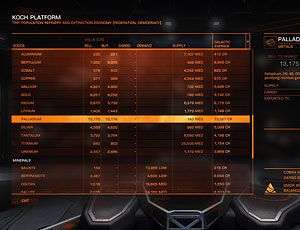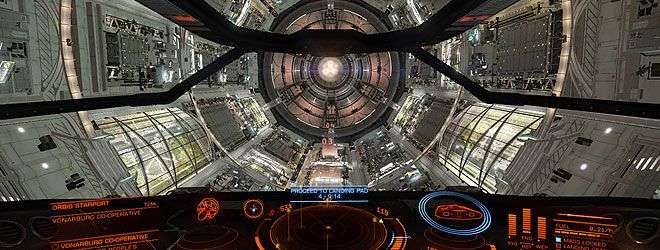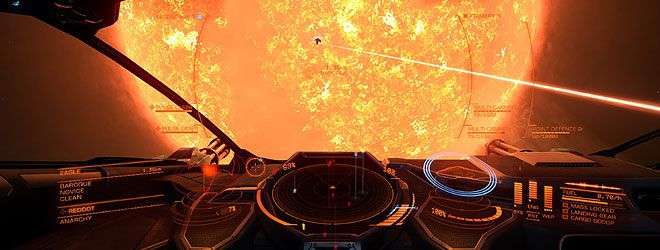Elite: Dangerous – Review
by Adam B
|
 You’re probably too young to remember Elite – hell, I’m barely old enough to remember it – the seminal space trading simulator from David Braben & Ian Bell. You see, in the old days games used to be made by one guy in his bedroom or sometimes two guys in a shed, and when you consider that Elite had 3D graphics and a massive simulated universe to freely explore, in 1984, that’s a pretty remarkable achievement.
You’re probably too young to remember Elite – hell, I’m barely old enough to remember it – the seminal space trading simulator from David Braben & Ian Bell. You see, in the old days games used to be made by one guy in his bedroom or sometimes two guys in a shed, and when you consider that Elite had 3D graphics and a massive simulated universe to freely explore, in 1984, that’s a pretty remarkable achievement.
Fast-forward thirty years and there’s a new Elite, and it is once again a remarkable achievement. As is now a legal requirement for all games, Elite Dangerous was successfully Kickstarted back in 2012, finally reaching release status in December of 2014. Much like the original Elite, the premise is a simple one: you are a space-guy (or space-girl), you begin your journey in a random space station with 1,000 credits to your name, and a loaned Sidewinder ship; what you do from there is entirely up to you.
Fundamentally, there are three main career tracks: Combat, Trading & Exploration, with the addition of Mining as an extension to trading. The former consists of either Bounty Hunting or Piracy while Exporation involves the discovery and mapping of the 400 billion (yes, billion) solar systems open to you. Trading was very much the core of the original Elite and it plays a very strong part here as well; in theory it’s as simple as buying a cheap commodity from one station, flying it to another one with a high demand, and then selling it; in practice it’s a little more complicated.
 While you can use the old pen and paper or Excel spreadsheet to keep track of prices across the galaxy, there are better ways – this is the future, after all. You can buy trade data in-game, which will help to show where goods are imported to and exported from, but it won’t simply tell you if a journey will be profitable or not. If you’re willing to use such things, there are also third-party crowd-sourced tools which will allow you to lookup current prices for a multitude of commodities across thousands of systems, something which, frankly, I think should be built into the game, at least to the extent of collecting that data from stations you’ve visited for later comparison.
While you can use the old pen and paper or Excel spreadsheet to keep track of prices across the galaxy, there are better ways – this is the future, after all. You can buy trade data in-game, which will help to show where goods are imported to and exported from, but it won’t simply tell you if a journey will be profitable or not. If you’re willing to use such things, there are also third-party crowd-sourced tools which will allow you to lookup current prices for a multitude of commodities across thousands of systems, something which, frankly, I think should be built into the game, at least to the extent of collecting that data from stations you’ve visited for later comparison.
I began my life in Elite by taking a courier job from the station bulletin board; these missions give you a pile of goods, a destination, and a promise of cash on delivery – they’re a good way to get started when you can barely afford to buy fuel. I hit the launch button and waited as my ship was lifted from its hangar into the station interior. It was a huge cylindrical, Babylon 5-esque affair with other ships coming and going, and the blue-hued rectangle of the docking port in the distance. Taking off and retracting my landing gear, I made my way towards the exit, pausing briefly to ensure I didn’t get totalled by a Lakon Type-9 Heavy freighter coming the other way, and then I emerged into the blackness of space – the whole experience was pretty breathtaking.
If there’s one thing Elite Dangerous has nailed, it’s the aesthetic. Ships are diverse and detailed in their design, from the tiny Hauler – very much the Bedford Rascal of the Elite universe – to the sleek Eagle and Viper fighters, through the heavy duty Lakon freighters, and the ludicrous NPC capital ships. Every ship has a unique interior and they are fantastic; every in-game menu is an actual menu on an actual display in your ship that you can freely look at while flying. If part of your cockpit windscreen gets blown out, you can no longer see targeting and range-finding information through that section because it’s actually projected onto the glass and isn’t simply a videogame construct that appears on your monitor.
We all know that space is big and mostly empty, but Elite has done a good job of making it visually interesting without requiring too much suspension of disbelief. Every system has a unique skybox that includes all of the nearby stars in their correct positions along with any nebulae or other astronomical phenomena that may be visible.
 Travelling between systems is relatively fast – essentially just an animated loading screen – albeit limited by your jump range, and you will always jump to the most massive body in a system, but that’s not always close to where you want to be. Intra-system travel in Elite takes time, anything from twety seconds to forty-five minutes depending on the distance you have to travel. The flight model is more or less Newtonian (with a few nods towards usability) and so you have to both accelerate and decelerate smoothly to reach your destination; you can’t simply drop out of Super Cruise at fifteen times the speed of light when you get within a few million miles of your target. Well, you can, but it usually results in your hull being torn apart and a hefty insurance-rate hike.
Travelling between systems is relatively fast – essentially just an animated loading screen – albeit limited by your jump range, and you will always jump to the most massive body in a system, but that’s not always close to where you want to be. Intra-system travel in Elite takes time, anything from twety seconds to forty-five minutes depending on the distance you have to travel. The flight model is more or less Newtonian (with a few nods towards usability) and so you have to both accelerate and decelerate smoothly to reach your destination; you can’t simply drop out of Super Cruise at fifteen times the speed of light when you get within a few million miles of your target. Well, you can, but it usually results in your hull being torn apart and a hefty insurance-rate hike.
Speaking of insurance, Elite doesn’t have perma-death (yet; a Hardcore mode has been mooted) but there are some pretty stiff penalties for copping it. If you have the money (usually somewhere around 5% of the net worth of your ship) you can claim on your insurance and re-buy your old ship; if you find yourself a little short you can take out a loan, but if you really can’t come up with the cash you’re back to the starting Sidewinder again. Regardless of whether or not you can afford to replace your ship, you also lose your cargo, any missions in progress, any bounties you’d earned but not cashed in yet, and you’ll find yourself back in the last station you docked at.
Combat is fun, although it suffers from the classic space-combat problem of there being a lot of flying around in a loop trying to get behind the other guy to hit them, but there are ways to work around the problem if you’re smart (or have a big enough ship to just mount turrets on your hardpoints). Bounty-hunting and piracy can both be very profitable careers, but you’ll generally find the NPCs to be far easier targets than other humans, even if they’re are almost always worth much less. There are currently fifteen playable ships in the game with at least another three confirmed to be added as the game develops, but they’re not cheap; the current top of the line ship, the Anaconda, clocks in at 146,969,451 credits.
 As fun as Elite is, it’s not without its issues; it still has a lot of features and content in development, and the social features are seriously lacking. Playing with your friends is difficult; you’ll often start hundreds of light years apart, and while it’s fairly easy to get into the same instance once you do get together, there’s no easy way to travel as a group and the voice and text chat ranges from poor to utterly non-functional, so you’re going to need a third-party solution if you want to stay in contact. Additionally, systems such as mining are still in the early stages of development and can be incredibly tedious to perform; now one might argue that mining is incredibly tedious, but things like having to scoop up every individual bit of ore rather than having some kind of drone or tractor beam to do it moves things from merely monotonous to downright frustrating.
As fun as Elite is, it’s not without its issues; it still has a lot of features and content in development, and the social features are seriously lacking. Playing with your friends is difficult; you’ll often start hundreds of light years apart, and while it’s fairly easy to get into the same instance once you do get together, there’s no easy way to travel as a group and the voice and text chat ranges from poor to utterly non-functional, so you’re going to need a third-party solution if you want to stay in contact. Additionally, systems such as mining are still in the early stages of development and can be incredibly tedious to perform; now one might argue that mining is incredibly tedious, but things like having to scoop up every individual bit of ore rather than having some kind of drone or tractor beam to do it moves things from merely monotonous to downright frustrating.
I think it’s probably best to view these things through the lens of an MMO; the game launch was basically flawless and there’s plenty of content if you like being in space and doing spacey things, but there’s still a lot that needs polishing, and new stuff to come in the near future. That said, don’t treat playing it like an MMO, because if you try and see it as some kind of grind-race to the “endgame” you’ll quickly burn yourself out – Elite is very much about the journey rather than the destination.
So, the big question – should you buy Elite right now? The answer is simple: if you love the idea of being a space-trucker, space-bounty hunter, space-pirate, or space-explorer, and being able to write your own story in a largely accurate recreation of our galaxy then you should absolutely buy Elite right now. If those things appeal to you but you want something with more social aspects, then you should wait a couple of months for those features to mature and then you should absolutely buy Elite. If you’ve never dreamed of being a space-guy doing space stuff in space then I feel very sorry for you and Elite probably isn’t the game for you.
Pros- Spaceships!
- 400 billion star systems to explore
- Looks beautiful
- Lots of spaceships!
- Wonderfully immersive experience
- Social features lacking
- Mining is currently very dull
- Can become a grind if you focus on a single career track
- Always online requirement
Elite Dangerous is everything you could want from an Elite sequel/reboot utilising an almost unimaginably large and beautiful game world with plenty of things to do in it. It has its issues and will require substantial further development to reach its full potential but everything I've seen from Frontier Developments during the Beta, Gamma, and final release of the game leads me to believe they're capable of pulling it off.
Last five articles by Adam B
- Deus Ex: Mankind Divided - Review
- No Man's Sky - Review
- The Curious Tale of The Consoles That Became PCs
- Quality of Life
- Why You Should Be Watching Dota 2 Right Now
























Visually stunning and the space stations made me soil myself they were so gorgeous. Good gameplay although I recon it would only last a few tens of hours as it all gets a little samey unless you are a die hard fan.
Hard to believe this is the same Elite Dangerous game that actually shipped – incomplete, severely lacking in content nd bugged to hell. A pale shadow of the game Braben promised and backers paid him for.